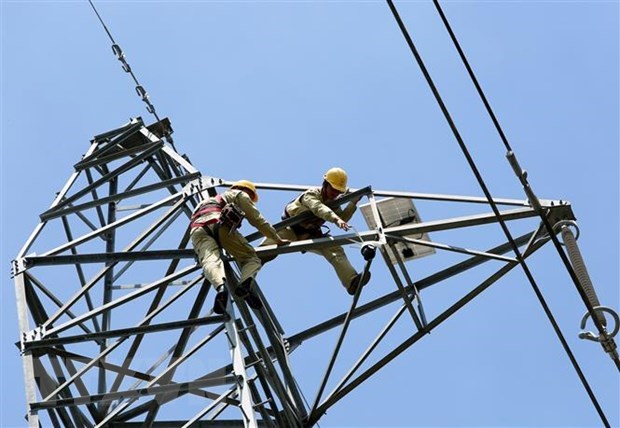Power transmission grid should be developed: insiders
As the country’s total power output will expand by 80,000 MW by 2030, while large sources are located far from centres, it is necessary to develop sufficient power transmission grid to ensure stable operation of the whole system, according to Deputy Minister of Industry and Trade Hoang Quoc Vuong.
 It is necessary to develop sufficient power transmission grid to ensure stable operation of the whole system (Photo: VNA).
It is necessary to develop sufficient power transmission grid to ensure stable operation of the whole system (Photo: VNA).Hanoi (VNA) – As the country’s total power output will expand by 80,000 MW by 2030, while large sources are located far from centres, it is necessary to develop sufficient power transmission grid to ensure stable operation of the whole system, according to Deputy Minister of Industry and Trade Hoang Quoc Vuong.
At the conference “Vietnam Power Development Plan for the 2021-2030 Perioud with vision until 2045” held in Hanoi on September 28, Vuong said the large resources such as coal, gas and liquefied natural gas (LNG) power plants will increase their capacity by more than 30,000 MW, and onshore and offshore wind and solar power mills by nearly 30,000 MW.
The trend of power transmission is likely to change, which means instead of transmitting power from the north and central regions to the south like in the past, the direction will be in the opposite, Vuong said, stressing the transmission grid development plan should be studied meticulously in the power development Master Plan 8.
Deputy head of the Electrical System Development Department under the Institute of Energy Nguyen Manh Cuong said under Master Plan 8, the country needs to develop transformation stations with capacity totaling 81 GVA for the 12,000 kilometres of the 500 kV transmission line, and 83 GVA for some 20,000 kilometres of the 220 kV transmission line during 2021-2030.
In the next decade, 1,200 kilometres of 500 kV transmission line and 2,000 kilometres of 220 kV transmission line will be put into operation each year on average as compared to the current 400 kilometres and over 1,000 kilometres, respectively, he added.
Investment for the 500 kV and 220 kV transmission lines is a big challenge for the power sector, as the amount doubles the current capacity, he added.
The capacity of the whole system is expected to reach about 138,000MW by 2030 and 302,000MW by 2045, of which priority is given to the development of renewable energy sources in accordance with the potential of each region to ensure safety. Coal-fired thermal power will be reduced gradually, with an increase in gas thermal electricity to compensate.
Meanwhile, Le Thi Thu Ha, a representative from the Electricity Institute, said the power sector is desperate for 133.3 billion USD to develop the power source and grid system during 2021-2030, which means it needs 13.3 billion USD for power investment each year.
Since power development Master Plan 8 has a close link with other sectors like coal, oil and gas, renewable energy, transport, socio-economy and urban space, specific and rational mechanisms and policies must be outlined to successfully carry out all power projects under the master plan so as to ensure a stable supply of electricity, serving the socio-economic development in the coming time, Vuong said./.












